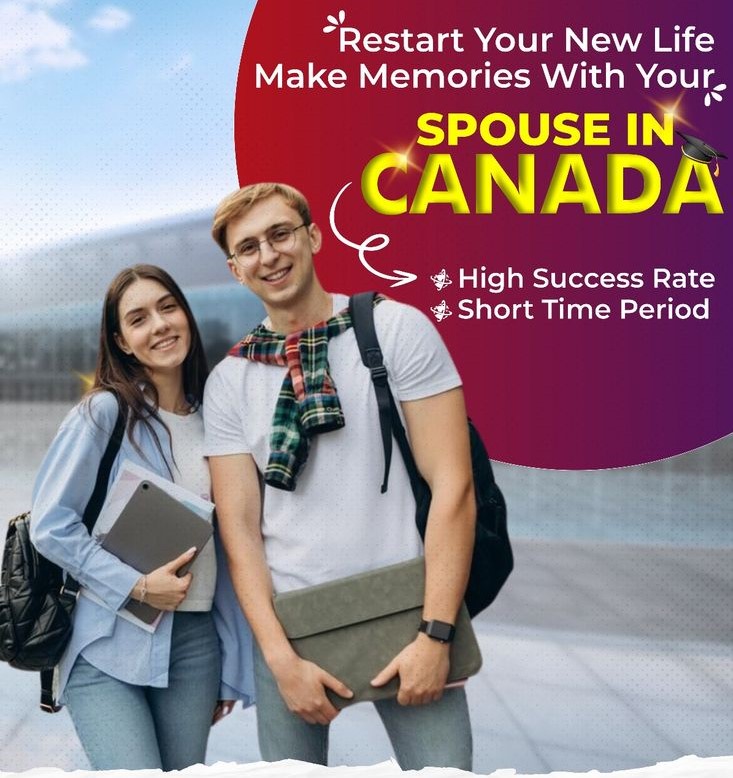Visa sponsorship through marriage is a widely utilized pathway for obtaining legal residency or citizenship in many countries. However, navigating this process requires careful attention to legal requirements, documentation, and timelines. Whether you’re pursuing residency in the U.S., Canada, or Europe, understanding the intricacies of visa sponsorship through marriage can help streamline the process. This guide explores the steps, challenges, and tips to successfully secure a marriage-based visa.
Why Marriage-Based Visa Sponsorship is Popular
Marriage-based visa sponsorship remains one of the most sought-after immigration pathways globally. It offers unique advantages for individuals seeking permanent residency, work opportunities, or a path to citizenship. Here’s an in-depth look at why this route is increasingly popular:
1. Direct Pathway to Legal Residency
One of the most significant advantages of marriage-based visa sponsorship is its ability to provide a direct route to legal residency. Unlike other visa categories, which may involve lengthy waiting periods and strict quotas, marriage-based visas are often prioritized.
- Permanent Residency: Many countries, such as the U.S., Canada, and European nations, allow spouses of citizens or lawful permanent residents (LPRs) to apply for green cards or equivalent residency permits.
- Stability and Security: Obtaining legal residency ensures access to healthcare, education, and other benefits, making this option appealing to couples looking for a stable future.
2. Expedited Processing for Spouses of Citizens
Marriage-based visas for spouses of citizens are typically processed faster than other family or employment-based visas. This prioritization reflects the importance placed on family reunification by immigration authorities.
- No Annual Caps: Unlike some visa categories limited by annual quotas, immediate relatives (including spouses) of citizens often face fewer delays.
- Streamlined Application Processes: Some countries offer expedited options, such as fiancé visas, allowing couples to marry and apply for residency without prolonged separation.
3. Access to Employment and Educational Opportunities
Marriage-based residency often includes work authorization, granting spouses the ability to secure employment without additional sponsorship. This opens doors to career advancement and financial independence.
- Work Opportunities: Residency through marriage allows individuals to apply for high-demand roles, such as those highlighted in Visa Sponsorship Jobs in the UK: Industries Hiring Now.
- Educational Benefits: Spouses may also qualify for in-state tuition rates or financial aid, making advanced education accessible. Scholarships like Best Fully Funded Scholarships in the UK for International Students further enhance opportunities for academic growth.
4. Simplified Pathway to Citizenship
Marriage-based visa sponsorship often accelerates the journey to citizenship. Many countries shorten the naturalization timeline for spouses of citizens.
- U.S. Example: Green card holders married to U.S. citizens can apply for citizenship after just three years, compared to five years for other green card holders.
- Canada’s Spousal Sponsorship: Spouses who become permanent residents can apply for Canadian citizenship after meeting residency requirements. Learn more in How to Secure Permanent Residency in Canada Through Marriage.
5. Enhanced Mobility and Travel Opportunities
Spouses who obtain residency or citizenship through marriage gain access to the sponsor’s country and the ability to travel more freely. This benefit is particularly valuable for international couples.
- Visa-Free Travel: Residency or citizenship often allows for visa-free travel to multiple countries, especially within regions like the European Union (EU).
- Cultural Integration: Living in a new country provides the opportunity to embrace local customs, languages, and traditions, enriching the individual’s personal and professional life.
6. Family Reunification
For couples separated by borders, marriage-based visa sponsorship offers a legal and structured way to reunite and build a life together. Immigration policies worldwide prioritize family reunification, making this process a cornerstone of many systems.
Complementary Opportunities to Explore Alongside Marriage-Based Visa Sponsorship
While marriage-based sponsorship is a reliable path, it can be combined with other opportunities to maximize personal and professional growth:
-
Educational Advancement
- Explore options like Fully Funded Exchange Programs for Students to advance academically while residing in your spouse’s country.
- Career Opportunities
- Utilize work authorization gained through residency to apply for roles in high-demand sectors. Start with guides such as List of Companies Offering Visa Sponsorship Jobs for Immigrants.
Marriage-based visa sponsorship is not just about immigration; it’s a pathway to building a future enriched with opportunities. From gaining legal residency and expedited processing to accessing education, employment, and citizenship, this process provides a foundation for success.
For those navigating this route, leveraging related resources like How to Apply for a Family-Based Visa Sponsorship in the USA can further enhance the journey. With the right preparation and understanding of the system, couples can seamlessly transition into their new life together.
Eligibility Requirements for Marriage-Based Visas
Marriage-based visas offer a pathway to residency and citizenship, but they come with strict eligibility requirements to ensure integrity and compliance with immigration laws. While specific rules vary by country, the following universal criteria apply across most jurisdictions:
1. Legal Marriage
The cornerstone of a marriage-based visa application is the validity of the marriage.
- Recognition of Marriage: The marriage must be legally recognized in the country where it was performed.
- Civil marriages: Typically valid worldwide, provided they adhere to the local laws of the country of origin.
- Religious marriages: Accepted in many cases, though additional documentation may be required to confirm legality.
- Age of Consent: Both parties must meet the minimum age for marriage as stipulated by their respective legal systems.
- Proof of Legality: A marriage certificate is typically the primary document required to confirm the validity of the union.
Pro Tip: If you are in a relationship but not yet married, exploring fiancé visa options might be helpful. Check out resources like Can Marriage Help You Secure a Visa Sponsorship? Here’s What to Know for detailed insights.
2. Proof of a Bona Fide Relationship
Immigration authorities require evidence that the marriage is genuine and not entered into solely for immigration benefits.
- Key Documentation:
- Joint financial records (e.g., shared bank accounts, loans, or property ownership).
- Photos together over time, preferably with family and friends.
- Correspondence showing regular communication (e.g., emails, text messages, or call logs).
- Affidavits from family and friends attesting to the authenticity of the relationship.
- Living Arrangements: Demonstrating cohabitation strengthens the case but is not always mandatory.
Warning: Fraudulent marriages are strictly penalized, often leading to visa denial, fines, or even deportation. To better understand how genuine relationships impact immigration status, review How to Apply for a Family-Based Visa Sponsorship in the USA for guidance.
3. Sponsor’s Status
The sponsoring spouse plays a critical role in the visa process. Their status determines the type of visa and eligibility timeline for the beneficiary.
- Citizen Sponsors:
- U.S. citizens can sponsor their spouse for an immigrant visa or green card with fewer delays, as these applications are not subject to annual caps.
- Similar expedited processing applies in countries like Canada and the UK.
- Lawful Permanent Residents (LPRs):
- LPRs can sponsor their spouses, but applications may take longer due to visa quotas and waiting lists.
- The sponsor must maintain their legal status throughout the application process.
Related Reading: Learn how permanent residency through marriage compares globally in How to Secure Permanent Residency in Canada Through Marriage.
4. Financial Ability
Sponsors must demonstrate the financial capacity to support their spouse and prevent the beneficiary from becoming reliant on public assistance.
- Income Threshold: Many countries require sponsors to meet a minimum income level, often calculated as a percentage above the poverty line.
- Proof of Financial Support:
- Tax returns or pay stubs.
- Bank statements showing sufficient savings or assets.
- Employment verification letters.
- Affidavit of Support: Sponsors may need to file a formal affidavit (e.g., Form I-864 in the U.S.) promising to provide financial support to the beneficiary.
Pro Tip: If you’re combining marriage-based sponsorship with academic pursuits, review Fully Funded Exchange Programs for Students: How to Apply to explore funding options for study and living expenses.
Additional Considerations
Health and Security Clearances
Most countries require the beneficiary to pass:
- A medical examination to confirm they meet health standards.
- Background checks to ensure they pose no security risk.
Cultural and Language Integration
Certain countries may require the beneficiary to demonstrate cultural or linguistic integration. This could involve passing basic language tests or attending cultural orientation sessions.
Travel Restrictions During Processing
While the application is under review, travel restrictions may apply to the beneficiary. Planning ahead is crucial to avoid complications.
Meeting the eligibility requirements for marriage-based visas is the first step in securing a life together in your chosen country. By ensuring your marriage is legal, genuine, and backed by adequate financial support, you set the stage for a successful application. To maximize your chances of approval, consider leveraging resources like Step-by-Step Guide to Securing a Visa Sponsorship Job in Germany for additional pathways to integration and financial stability.
With careful preparation and attention to detail, you can navigate the process smoothly and build a bright future with your spouse.
Step-by-Step Guide to Applying for a Marriage-Based Visa
Step 1: Determine the Right Visa Type
The first step in the marriage-based visa sponsorship process is identifying the appropriate visa type based on the sponsor’s citizenship or residency status and the applicant’s current location. Selecting the right visa ensures a smoother application process and reduces the chances of delays or denials.
1. Spousal Visa
A spousal visa is ideal for couples who are already married and intend for the foreign partner to join the sponsoring spouse in their home country.
Key Features:
- Eligibility: Requires proof of a valid and legal marriage recognized by the sponsor’s country.
- Purpose: Grants the applicant the ability to live, work, and study in the sponsor’s country, often leading to permanent residency or citizenship.
- Application Process:
- Submission of marriage certificates and supporting documentation.
- Medical and background checks for the applicant.
Examples:
- U.S. Spousal Visa (CR1/IR1): Designed for the spouses of U.S. citizens or lawful permanent residents.
- UK Spouse Visa: Requires meeting specific income thresholds and English language proficiency.
Pro Tip: If you’re considering educational opportunities while relocating, explore resources like Best Fully Funded Scholarships in the UK for International Students for academic and financial support.
2. Fiancé Visa
For couples not yet married, a fiancé visa provides a pathway for the foreign partner to enter the sponsor’s country and marry within a specified period.
Key Features:
- Eligibility: Requires proof of an ongoing, bona fide relationship, such as photos, correspondence, or evidence of in-person meetings.
- Timeline: Most fiancé visas grant a limited time (e.g., 90 days for the U.S. K-1 visa) for marriage after arrival.
- Transition to Spousal Visa: After the marriage, applicants must adjust their status to obtain permanent residency.
Examples:
- U.S. K-1 Fiancé Visa: Requires proof of meeting in person at least once in the past two years unless exempt for cultural or religious reasons.
- Canada’s Conjugal Partner Visa: For couples in exceptional circumstances preventing legal marriage but demonstrating a committed relationship.
Pro Tip: While planning your move, consider job opportunities to enhance financial stability. Explore resources like Top 5 Websites to Find Visa Sponsorship Jobs Anywhere in the World to secure employment alongside your visa.
Key Factors to Consider When Choosing a Visa Type
- Sponsor’s Residency or Citizenship Status:
- Citizens often have faster processing times compared to lawful permanent residents.
- Fiancé visas are typically restricted to citizens in many countries.
- Applicant’s Current Location:
- Outside the Sponsor’s Country: Spousal or fiancé visas require consular processing through an embassy.
- Inside the Sponsor’s Country: Adjustment of status may be an option for those already on temporary visas.
- Timeframe for Relocation:
- Fiancé visas generally have a quicker entry process but come with stricter timelines for marriage.
- Spousal visas may take longer to process but provide immediate stability after approval.
- Long-Term Goals:
- For couples planning a permanent move, spousal visas often provide a more straightforward pathway to residency and citizenship.
Tips for Enhancing Your Visa Application
- Strengthen Your Relationship Evidence: Collect and organize documents, photos, and testimonials to demonstrate the authenticity of your relationship.
- Seek Legal Assistance: Navigating visa requirements can be complex. Immigration attorneys can guide you through the process and improve your chances of success.
- Consider Educational and Employment Opportunities: Relocating can be an opportunity to advance professionally or academically. Look into resources like Guide to Securing a Fully Funded Scholarship in Europe for scholarships that might ease financial burdens.
Choosing the right visa type is a crucial first step in the marriage-based sponsorship process. Whether you opt for a spousal or fiancé visa, thorough preparation and understanding of requirements can pave the way for a successful application.
Invest time in researching all available options to ensure the best possible outcome for you and your spouse.
Step 2: File the Appropriate Forms
For the U.S.
- Form I-130: Petition for Alien Relative (for spouses outside the U.S.).
- Form I-485: Adjustment of Status (for spouses already in the U.S.).
For Canada
- IMM 1344: Application to Sponsor.
- IMM 5533: Document Checklist for Spouses and Partners.
Step 3: Provide Proof of Relationship
This step is critical to avoid suspicion of fraud. Include the following:
- Wedding photos and invitations.
- Joint bank account statements.
- Lease or mortgage agreements showing shared residence.
- Communication records such as emails or text messages.
Step 4: Attend the Interview
The immigration interview is often the final step, where officers evaluate the authenticity of your relationship. Be prepared to answer questions about:
- How you met your spouse.
- Daily life and future plans as a couple.
- Family interactions and significant events.
Pro Tip: If pursuing post-residency opportunities, explore guides like How to Secure a Visa Sponsorship Job in Canada to understand work-related benefits of residency.
Challenges in the Marriage-Based Visa Process
- Long Processing Times: Spouses of LPRs may face significant delays due to visa caps.
- Intense Scrutiny: Immigration authorities rigorously evaluate applications to detect fraud.
- Financial Requirements: Sponsors must meet income thresholds, which can be challenging for those with limited resources.
Special Considerations for Different Regions
United States
The U.S. offers two main routes for marriage-based immigration:
- Spouse of a Citizen: Fast-tracked with no annual visa limits.
- Spouse of an LPR: Subject to visa quotas, leading to longer wait times.
Canada
Canada allows spousal sponsorship through its family reunification program. This process often leads to permanent residency and provides access to opportunities like Study in Canada: Fully Funded Visa Sponsorship Opportunities for Students.
Europe
European countries vary in their approach to marriage-based visas. Nations like Germany and the UK require language proficiency and integration courses. Meanwhile, some applicants leverage resources such as Top 5 Websites to Find Visa Sponsorship Jobs Anywhere in the World for additional opportunities.
Common Misconceptions About Marriage-Based Visas
- Marriage Guarantees Residency: A legal marriage does not automatically grant residency. You must still meet all immigration requirements.
- Immediate Processing: While some cases are expedited, others face lengthy reviews.
- No Need for Proof: Substantial evidence is required to demonstrate a bona fide relationship.
Pro Tip: If considering other pathways to legal status, explore options like How to Apply for a Family-Based Visa Sponsorship in the USA for detailed guidance.
Alternatives to Marriage-Based Visa Sponsorship
For individuals exploring other immigration options, consider:
- Employment-Based Sponsorship: Explore Visa Sponsorship Jobs in the UK: Industries Hiring Now for work-related pathways.
- Educational Opportunities: Programs that can provide a temporary foothold.
Marriage and Residency: A Path to Citizenship
Marriage-based visas often lead to citizenship through naturalization. For example:
- In the U.S.: Green card holders married to U.S. citizens can apply for citizenship after three years.
- In Canada: Spouses with permanent residency may apply for citizenship after meeting residency requirements.
Can Marriage Help You Secure Permanent Residency in Canada?
Yes, marriage is one of the most straightforward pathways to permanent residency in Canada. Through the spousal sponsorship program, applicants gain access to benefits like healthcare, employment, and education. Learn more in How to Secure Permanent Residency in Canada Through Marriage.
Tips for a Successful Application
- Start Early: Begin gathering documents and filing applications well before your intended timeline.
- Stay Honest: Any attempt to falsify information can lead to denial and even legal consequences.
- Consult an Expert: Immigration attorneys can provide valuable assistance, especially in complex cases.
Conclusion
Visa sponsorship through marriage is a promising but complex process. From submitting accurate applications to preparing for interviews, every step requires attention to detail. By understanding the requirements and challenges, you can navigate the process more effectively.
Additionally, leveraging complementary opportunities like How to Apply for a Scholarship That Covers Both Tuition and Visa Costs can enrich your journey. Whether you’re aiming for legal residency or citizenship, marriage-based visas provide a pathway to a new beginning in your chosen country.




